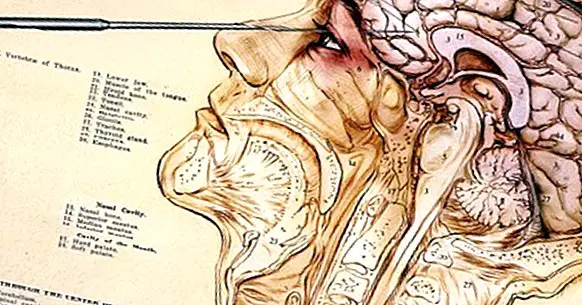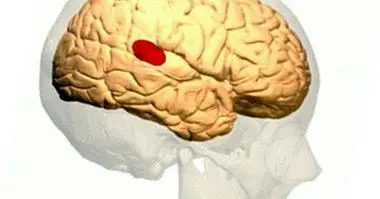What is a lobotomy and with what purpose was it practiced?
In 1935, the Portuguese neurosurgeon and psychiatrist António Egas Moniz He performed a surgical procedure called a leucotomy.
It consisted of making two holes in the front of the skull, and injecting alcohol directly into the frontal lobe of the brain through them. Years later, this practice had been renamed lobotomy , and his popularity in the world of psychiatry caused Egas Moniz to win the Nobel Prize in Medicine in 1949. What had happened?
The birth of the lobotomy
The etymology of the term leucotomía serves to make us an idea about the objective with which the lobotomías were realized; leuko means white, and take means cut. Egas Moniz believed that certain mental disorders could be cured by breaking up some areas of the brain in which the frontal lobe communicates with other areas of the brain. That is, damaging parts of white matter of the brain, so called because in it axons predominate (the parts of the neuron that elongate to communicate with distant nerve cells).
This neurosurgeon started from the idea that it was possible to considerably reduce the intensity and frequency of the symptoms of psychiatric disorders by making all his psychological functions in general decay. A part of the intellectual capacity and personality of each patient was sacrificed to try to bring it closer to healing.

The lobotomy of Walter Freeman
The Egas Moniz proposal may seem brutal today, but in its historical context it was well received in the field of non-Freudian psychiatry. In fact, in 1936, neurosurgeon Walter Freeman imported this type of intervention to the United States and, after giving it the name of lobotomy, it made it popular all over the world.
Freeman also introduced some changes to the procedure. After stunning the patients by electroshock, instead of piercing two points of the skull and inserting spikes through them, he used iceberg-like instruments that he introduced through the eye socket, between the eye and the bone part on which it is eyebrow, and removed trying to "sweep" parts of the frontal lobes of each cerebral hemisphere.
As the wounds did not reach the deepest part of the brain, the vital structures were not damaged and, in some cases, the patients hardly noticed changes during the first hours. In any case, the nervous system of these people was marked forever, and their way of behaving and experiencing life, too.
Why was lobotomy popularized?
It is hard to believe that the practice of lobotomies enjoyed good reputation for a period, but the truth is that it was.
After disclosing his method, Freeman came to perform more than 2,000 lobotomies throughout his career . The practice of lobotomy spread rapidly through all the countries of the West, and came to be considered one of the most useful tools that medicine could count on.
People who underwent voluntary or involuntary lobotomy were not only patients with serious mental disorders such as schizophrenia or severe depression; In many cases, this operation was used to solve behavioral problems, disobedient adolescents, etc. Maybe Freeman's method was brutal, but a good part of society was willing to embrace that brutality.
The idea of ending behavioral problems strongly rooted in the way of being with a few sessions was very tempting. In addition, if the lobotomized people were more "calm", they could put an end to conflicts and relational problems, simply putting the focus on an individual who had to "change".
The logic that was behind this good reception by a large part of the health institutions has to do with the hygienist mentality that they held. At that time people with psychiatric disorders were piled up in overcrowded hospitals , and many times they were subjected to physical or psychological violence.
The lobotomy offered the opportunity to make this type of problem less obvious, easier to ignore. The patients were still sick, but after the operation it was less noticeable that they were there. The problem was solved in the fiction and, in any case, the alternative to this practice was also terrible.
The appearance of psychotropic drugs and the end of the ice pick
The popularity of lobotomies began to plummet not due to a spontaneous awareness on the part of the population, but rather a less romantic event: the emergence of the first generations of psychotropic drugs for severe mental disorders, in the middle of the years fifty.
The lobotomy promised an apparent quick solution to behavioral problems from a few sessions, a mercantile exchange that, taking into account the many problems that could be solved (in the family, at work, etc.), came to mind. But nevertheless, the psychotropic drugs were not only much more effective , but also its application was much simpler.
Similarly, when one of Freeman's patients died from the hemorrhage caused by the neurosurgeon, it became clear that the risks of lobotomy were high. In the 50s and 60s, many countries banned this kind of interventions , and the USSR came to consider it "contrary to human rights".
In any case, the lobotomy had enjoyed such a good image that it took a couple of decades to appear. The simplicity of the procedure (which could be done in less than 10 minutes) continued to make this measure an attractive option when there was no monitoring by relatives or public entities.
Bibliographic references:
- Cosgrove, G. Rees; Rauch, Scott L. (1995). "Psychosurgery" Neurosurg. Clin. N. Am.
- Martínez, Luis Antonio (2009). Reconstructive regressive therapy. Books on the Net.



















